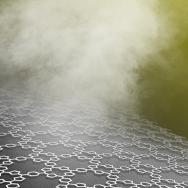Understanding Earth’s carbon cycle has important implications for understanding climate change and the health of biospheres. But scientists don’t yet understand how much carbon lies deep in Earth’s water reservoirs—for example, in water that is under extreme pressure in the mantle—because experiments are difficult to conduct under such conditions.
Researchers at the Pritzker School of Molecular Engineering at the University of Chicago and the University of Science and Technology in Hong Kong have created a complex computer simulation that will help scientists determine the concentration of carbon under the conditions of the mantle, which include temperatures of up to 1,000K and pressures of up to 10 GPa, which is 100,000 times greater than on the Earth’s surface.
These simulations provide an ingenious way to evaluate the missing link between measurements (in particular, vibrational spectra used to discover signatures of ions in water) and the ion and molecular concentrations in these conditions. This research, published recently in the journal Nature Communications, has important implications in understanding the Earth’s carbon cycle.
“Our computational strategy will greatly facilitate the determination of the amount of carbon at the extreme conditions of the Earth’s mantle,” said study co-author Giulia Galli, the Liew Family Professor of Molecular Engineering at UChicago, who is also a senior scientist at UChicago-affiliated Argonne National Laboratory.
“Together with many other research groups around the world, we have been part of a large project aimed at understanding how much carbon is present in the Earth and how it moves from the interior toward the surface,” said Ding Pan, former postdoctoral researcher at UChicago in Galli’s group, first author of the research, and current assistant professor of physics and chemistry in Hong-Kong University of Science and Technology. “This is one step toward building a comprehensive picture of carbon concentration and movement in the earth.”
A step toward better understanding the carbon cycle
Understanding how much carbon lies in deep reservoirs many miles underground is important because it is estimated that more than 90% of the Earth’s carbon is buried in its interior. That deep carbon influences the form and concentration of carbon near the surface, which ultimately can impact global climate change.
Unfortunately, there is no experimental technique yet available to directly characterize carbonates dissolved in water at extreme pressure and temperature conditions. Pan and Galli devised a novel strategy that combines spectroscopy results with sophisticated calculations based on quantum mechanics to determine the concentration of ions and molecules in water at extreme conditions.
By carrying out these simulations, Pan and Galli found that the concentration of a specific important species—bicarbonate ions—has been underestimated by previously used geochemical models. They proposed a new view of what happens when you dissolve carbon dioxide in water at extreme conditions.
“The determination of what happens when one dissolves carbon dioxide in water under pressure is critical to the understanding of the chemistry of carbon in the Earth’s interior,” Galli said. “Our study contributes to the understanding of the deep carbon cycle, which substantially influences the carbon budget near the Earth’s surface.”
Galli and Pan’s simulation were performed at the Research Computing Center at UChicago and at the Deep Carbon Observatory Computer Cluster. It is just one of the several investigations of ions in water and water at interfaces ongoing in Galli’s group.
General simulation tools to understand water
Gaining a deeper understanding of what takes place when water—and matter dissolved or suspended in water—comes into contact with those solids is the focus of the Argonne-led AMEWS Center. For example, in many water systems, a phenomenon known as fouling—the accumulation of unwanted material on solid surfaces to the detriment of function—occurs at interfaces.
“A huge number of the challenges we face surrounding water center on the interface between water and the materials that make up the systems that handle, process, and treat water, including ions, of course,” said Seth Darling, director of AMEWS and a PME fellow. “The quantum mechanical simulations of Galli, integrated with experiments, can make a real difference in understanding aqueous interfacial phenomena where ions, like the carbonates studied in Nature Communications, are present.”
Citation: ‘A first principles method to determine speciation of carbonates in supercritical water.’ Ding Pan and Giulia Galli. Nature Communications, Jan 21, 2020, doi.org/10.1038/s41467-019-14248-1
Funding: Department of Energy, Alfred P. Sloan Foundation, National Natural Science Foundation of China, Croucher Foundation and DOE through AMEWS
—Story was first published on the Pritzker Molecular Engineering website.

